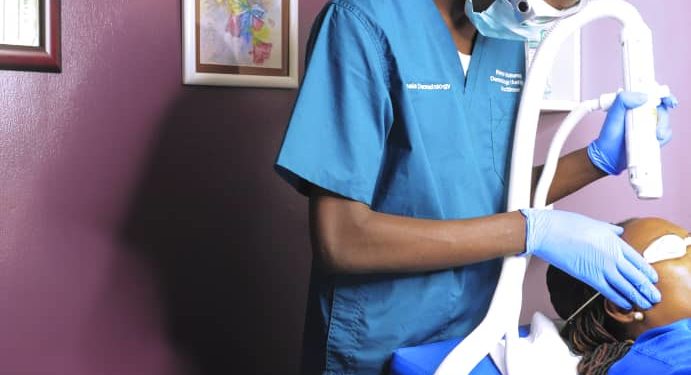By Michael Kanaabi Dollar
As the competition and quest to have the finest and most beautiful hair among the ladies both young and old rages on unintentionally so do the number of chemicals they apply to their hair, the heating treatment and the tight plaiting.
All these activities above if done persistently will in most cases lead to hair loss (Alopecia) among women sometimes even permanent hair loss if not stopped and treated medically in time according to Bugolobi based Kampala Dermatology clinic’s lead Specialist Dr. Ronald Katureebe.
He says “ Most ladies who use chemicals and dry heating to treat their hair with time develop a condition called Central Centrifugal scaring Alopecia (CCSA) which usually starts with hair thinning from the crown (centre of scalp) spreading out to other parts.”
For those that plait tight hair which often leads to scarring of the frontal and loss of hair too, they develop a condition called Traction Alopecia. It also affects the temporal (backside) of the scalp and sides too.
What are the signs and symptoms?
One of the first symptoms of CCSA is a feeling of tingling in the scalp mainly around the affected area. As it increases you will get pain in the scalp and next will be thinning of the hair starting from the crown usually according to Dr. Katureebe.
Finally you end up with hair loss if the symptoms and signs go unchecked over time.
For traction Alopecia scarring in the frontal and temporal (back parts) of the head where the real tight plaiting often occurs. The hair then starts to thin and if continued unchecked one develops permanent hair loss.
Other causes
Genetic predisposition is also a cause for Alopecia in women although it’s more common in men. Consultant Dermatologist Dr. Katureebe notes that this tends to manifest much later in women affecting ladies in their late 40s and 50s on wards unlike men who may show signs as early as their 20s.
Reason is its set off by male hormones called androgens that damage the hair follicles and is more present in men.
Scalp affecting conditions and diseases like severe dandruff, fungal infections, psoriasis, lupus may also cause hair loss.
Internal medical conditions like nutritional deficiency of iron and proteins in the body may lead to Alopecia too.
Diseases of the thyroid, acute stressful events like loss of a loved one, child birth etc. Use of medications like steroids, NCAIDs, other prescriptions for ulcers, blood pressure and cancer may also lead to hair loss.
There are other conditions too which may lead to hair loss and as a result Consultant Dermatologist Dr. Katureebe advises it’s best to seek the professional services of a Specialist to find the real cause and get proper treatment.
Management and treatment of Alopecia
The best way forward when it comes to treatment and management is see a Doctor as soon as you have any signs of thinning hair or hair loss.
“Reason is it is much easier to treat and where possible reverse when still in early stages, if you delay to seek help you may end up with permanent hair loss, ” Dr. Katureebe says.
For Alopecia in ladies resulting from chemical, heat treatment or tight plaiting, the first step is to suspend or stop the activity causing the hair loss immediately.
After that, Dr. Katureebe advises one is given medication which stimulates hair growth and strengthens the hair too. This may take the form of medical creams and supplements. Maintaining one’s scalp clean by using recommended shampoo will also help create an ideal environment for hair to grow again.
He adds that women experiencing the Alopecia forms laid out above should consider going natural with their hair and keeping it chemical free. In later stages a hair transplant can be done but Dr. Katureebe cautions this one is not recommended for young people as it’s a last resort for both men and women suffering permanent Alopecia.
Specifically for men suffering from progressive or permanent Alopecia, a specialised procedure called Scalp Micro Pigmentation can be arranged.
This procedure involves the use of special medical pigments to create an illusion of a new hair line and hair in the bald areas. The procedure involves no bleeding and is non invasive according to Dr. Katureebe, it is done in 2 to 3 sessions at most.
Getting a good uniform result from it will need one to keep the other bits of their hair short so as to match the pigmentation which looks like the new emerging hair after a recent haircut.
Email: michaelkanaabi@gmail.com Twitter: @michaelkanaabi WhatsApp: +256701133509
Do you have a story in your community or an opinion to share with us: Email us at editorial@watchdoguganda.com











